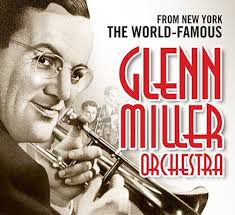 If Bing Crosby was big in 1934, he was massive a decade later, as the #1 hits of 1944 show. He sang on six of the 17 songs on the charts, two with the Andrews Sisters. His 1942 smash White Christmas went Top 5 pop and Top 10 R&B in 1944.
If Bing Crosby was big in 1934, he was massive a decade later, as the #1 hits of 1944 show. He sang on six of the 17 songs on the charts, two with the Andrews Sisters. His 1942 smash White Christmas went Top 5 pop and Top 10 R&B in 1944.
From A Century of Music by Joel Whitburn: “The recording industry enjoyed booming success during the early 1940s until the era’s dominant big bands were stilled on August 1, 1942, when the American Federation of Musicians joined in a ban on recording due to a dispute over musicians’ royalties. By the time all record companies entered into an agreement to end the ban in late 1944, vocalists had assumed predominance over bands in popularity.”
Of course, the US was amid World War II, as some of the song titles make clear.
BTW, because of competing charts, there were 88 weeks’ worth of #1 hits. All songs were on Decca Records except the two indicated.
Swinging On A Star – Bing Crosby, nine weeks at #1, gold record. From the Paramount picture Going My Way, for which he also scored an Oscar on March 15, 1945, portraying Father Chuck O’Malley in the 1944 film
Shoo Shoo Baby – The Andrews Sisters with Vic Schoen and his orchestra, nine weeks at #1. From the Universal picture Three Cheers For The Boys.
Don’t Fence Me In – Bing Crosby and The Andrews Sisters with Vic Schoen and his orchestra, eight weeks at #1, gold record, written by Cole Porter. From the Warner Brothers picture Hollywood Canteen.
The Beatles covered this.
Besame Mucho (Kiss Me Much) – Jimmy Dorsey with Bob Eberly and Kitty Kallen, seven weeks at #1. The song was performed on the Beatles Decca audition of 1 January 1962; the label passed on them.
I’ll Get By (As Long As I Have You) – Harry James with Dick Haymes (Columbia), six weeks at #1
(There’ll Be A) Hot Time In The Town of Berlin (When The Yanks Go Marching In) – Bing Crosby and the Andrews Sisters with Vic Schoen and his orchestra, six weeks at #1. The writing credits are Sgt. Joe Bushkin and Pvt. John De Vries.
You Always Hurt The One You Love – Mills Brothers, five weeks at #1, gold record
San Fernando Valley – Bing Crosby with John Scott Trotter and his orchestra, five weeks at #1. It was composed by Gordon Jenkins.
My Heart Tells Me (Should I Believe My Heart?) – Glen Gray with Eugenie Baird and the Casa Loma Orchestra, five weeks At #1. From the 20th Century Fox picture Sweet Rosie O’Grady
I Love You – Bing Crosby with John Scott Trotter and his orchestra, five weeks at #1. From Michael Todd’s Mexican Hayride. Written by Cole Porter.
My mom sang this.
Mairzy Doats – The Merry Macs, five weeks at #1. A novelty song that I remember my mother singing around the house. The lyrics.
I’ll Walk Alone – Dinah Shore (Victor), four weeks at #1. From the Universal film Follow The Boys. Jule Styne and Sammy Cahn wrote it.
I’ll Be Seeing You – Bing Crosby with John Scott Trotter and his orchestra, four weeks at #1
G.I. Jive – Louis Jordan and his Tympany Five, two weeks at #1. Johnny Mercer wrote it.
Into Each Life Some Rain Must Fall -Ink Spots and Ella Fitzgerald, two weeks at #1, gold record
I’m Making Believe – Ink Spots and Ella Fitzgerald, two weeks at #1, gold record. From the 20th Century Fox picture Sweet and Low-Down.
It’s Love-Love-Love – Guy Lombardo and His Royal Canadians with Skip Nelson and the Lombardo Trio, two weeks at #1

 In Joel Whitburn’s A Century of Pop Music, an interesting note. “The recording industry enjoyed booming success during the early 1940s until the era’s dominant big bands were stilled on August 1, 1942, when the American Federation of Musicians joined in a ban on recording due to a dispute over musicians’ royalties.
In Joel Whitburn’s A Century of Pop Music, an interesting note. “The recording industry enjoyed booming success during the early 1940s until the era’s dominant big bands were stilled on August 1, 1942, when the American Federation of Musicians joined in a ban on recording due to a dispute over musicians’ royalties. By 1931, in the midst of the Depression, the music business plummeted. According to A Century of Pop Music by Joel Whitburn, record sales hit only six million in 1932 compared “to the peak of 140 million only five years earlier. The opportunity to hear all the popular songs on the radio for free… also contributed to the desperate slump.”
By 1931, in the midst of the Depression, the music business plummeted. According to A Century of Pop Music by Joel Whitburn, record sales hit only six million in 1932 compared “to the peak of 140 million only five years earlier. The opportunity to hear all the popular songs on the radio for free… also contributed to the desperate slump.” Here’s a space oddity: David Bowie was only 69 years and two days old when he left us on January 10, 2016. That is not old at all, especially if you are a sexagenarian.
Here’s a space oddity: David Bowie was only 69 years and two days old when he left us on January 10, 2016. That is not old at all, especially if you are a sexagenarian.
